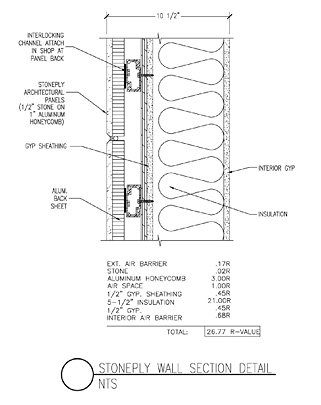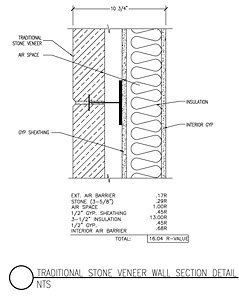StonePly & LEED Certification

Real Stone. Real Strong. Real Thin.

StonePly can play a role in attaining LEED certification. StonePly offers durability, reduced energy use, the opportunity for better insulation of the wall system, space savings as well as savings of transportation costs when compared with traditional stone cladding systems and when compared to other building materials.
These characteristics meet many of the requirements and goals of sustainable building design.
Real stone: granite, marble, travertine, limestone, onyx or virtually any other stone, bonded to an aluminum honeycomb backing. The resulting stone panels are lightweight, super strong, thin and waterproof.
LEED stands for Leadership in Energy and Environmental Design. The LEED Green Building Rating System was developed by the U.S. Green Building Council. LEED is a national voluntary program to define and measure what defines a "green" building. There are a variety of LEED categories, including LEED for new construction and major renovations (LEED-NC), existing buildings (LEED-EB), commercial interiors (LEED-CI), core and shell development (LEED-CS), and homes (LEED-H). Currently under development are rating systems for neighborhood development (LEED-ND), multiple buildings (LEED-MB), Schools, and Retail. The US Green Building Council (USGBC) is also currently developing application guides for Healthcare facilities, and Laboratories.
The goals of the LEED certification process are environmental performance, the improvement of occupant well being, and economic returns of facilities. Buildings are LEED certified if they achieve all of the prerequisites and at least 26 points out of a possible total of 69. LEED certification levels are:
| Level | Points Needed |
|---|---|
| Certified | 26 - 32 |
| Silver | 33 - 38 |
| Gold | 39 - 51 |
| Platinum | 52 - 69 |
These levels are awarded for total points on the project. Five environmental categories make up the LEED-NC rating system.
Each LEED category has multiple parts or credits to recognize sustainable building practices. A sixth LEED category recognizes innovative design.
These categories are:
| Credit Category | Category Points |
|---|---|
| Sustainable Sites | 14 |
| Water Efficiency | 5 |
| Energy and Atmosphere | 17 |
| Materials and Resources | 13 |
| Indoor Environmental Quality | 15 |
| Innovation and Design Process | 5 |
 Within each of the categories are several credits that can be used to achieve points toward certification. StonePly can play a role in achieving credits in the Energy and Atmosphere, Materials and Resources, Indoor Air Quality, and Innovation and Design Process categories.
Within each of the categories are several credits that can be used to achieve points toward certification. StonePly can play a role in achieving credits in the Energy and Atmosphere, Materials and Resources, Indoor Air Quality, and Innovation and Design Process categories.
ENERGY AND ATMOSPHERE (17 Points)
StonePly can contribute up to 10 points
Prerequisite 2 - Minimum Energy Performance
Summary:
This prerequisite sets a minimum standard for energy performance of a building.
StonePly® Contribution:
As it helps achieve points under EA Credit 1 for optimizing energy performance, the flexibility to provide additional insulation due to the thin nature of this product assists a building in meeting the prescribed Minimum Energy Performance criteria.
EA Credit1 - Optimize energy performance
The intent of this credit is to achieve increasing levels of energy performance above the prerequisite standard. Up to 10 points can be awarded for improvements of 15% - 60% above the standard for new buildings, or 5% - 50% improvement for existing buildings. The baseline standard used is ASHRAE/IESNA 90.1-1999. Improvements in performance are measured using the Energy Cost Budget Method found in Section 11 of the ASHRAE standard.
StonePly® Contribution: up to 10 points
StonePly® can contribute to achieving points in this category by allowing the use of thicker insulation within the wall system
MATERIALS AND RESOURCES (13 Points)
StonePly can contribute up to 9 points
MR Credit 1 - Building Reuse
Summary:
This category awards 1 point for 75% reuse of existing walls, floors, and roof; and 1 additional point for maintaining 100% of the existing walls, floors, and roof. LEED version 2.2 has lowered these thresholds, which will make it easier to qualify. 1 additional point is awarded for reuse of 50% or more of interior non-structural elements.
StonePly Contribution: 3 points
Because it is lightweight, StonePly can be used as an over cladding of existing walls. This allows for the old walls to be reused. Because the StonePly stone panels are thin and light weight, additional insulation can be added to existing exterior walls as illustrated with the description for EA credit 1.
MR Credit 2 - Construction Waste Management
Summary:
The intent of this credit is to divert construction, demolition, and land clearing debris from landfill disposal. One point is awarded for reusing 50% of the construction, demolition, and land clearing waste. One additional point is awarded for reusing 75%.
StonePly Contribution: 2 points
Because it is a prefinished material, StonePly generates very little construction waste. With what little waste there is, the stone can be crushed and used for aggregate and the aluminum recycled, contributing to these points.
MR Credit 3 - Resource Reuse
Summary:
This LEED credit is intended to reuse materials and products to reduce the demand for virgin items.
StonePly Contribution: 2 points
Materials salvaged onsite do not apply to this section, but do count toward Credit 1.1. 2 points can be earned for using salvaged building materials for 5% and 10% of building materials respectively. Salvaged stone can be used as the stone portion of the StonePly Panel.
MR Credit 4 - Recycled Content
Summary:
Awards up to 2 points for using building products that incorporate recycled content materials. 1 point is given when materials with the sum of post-consumer recycled content plus ½ the post-industrial content constitute at least 10% of the total dollar value of materials in the project. If the sum of post-consumer recycled content plus ½ the post-industrial content equals 20% or more, an additional 1 point is awarded.
StonePly Contribution: 2 points
85% of the aluminum incorporated into StonePly is recycled material with 55% coming from post-consumer sources. By weight, the aluminum is 25% of the total weight of a panel. On a typical panel with 3/16" marble face and 13/16" aluminum honeycomb backing, the aluminum is 25% of the total weight of a panel. The following recycled content is present: (numbers will vary with different thicknesses of stone or backing):
| StonePly Recycled Content | |
|---|---|
| Total Recycled Content by Weight | 21% |
| Post Industrial | 7.25% |
| Post Consumer | 13.75% |
Indoor Air Quality - 15 Points
StonePly can contribute up to 5 points
General Summary:
Some construction materials contain volatile organic compounds (VOCs) that can be released into the air as the products age. Some carpets and some wood products contain binders that release formaldehydes and other compounds into the air that can accumulate to unhealthy levels, especially in building that are tightly sealed for energy conservation. Other materials contain cellulose, paper, sugars, and other compounds that support mold growth. StonePly does not contain significant VOCs and does not contaminate indoor air. Produced from aluminum and natural stone, StonePly is waterproof and does not support mold growth and is not damaged by moisture. By reducing the need for paint or other wall coverings, improvements in indoor air quality are possible. Interiors clad with StonePly granite, marble or travertine panels do not need painting or repainting.
Prerequisite1 - Minimum IAQ Performance
Summary:
Critical to a "Green building" is the indoor environmental Quality. This category relates to the health and productivity of the installers as well as the final occupants of the building. Prereq. 1 sets a minimum standard required on all LEED buildings.
StonePly Contributions:
As mentioned in the general summary above, StonePly does not promote the growth of mold, and does not introduce significant levels of VOCs to a buildings interior. This is an important part of designing a buildings interior and evaluating the materials effect on that environment.
EQ Credit 3 - Indoor Air Quality (during & after construction)
Summary:
This credit establishes measures to control the indoor air quality during the construction phase of the project, and provides for a healthy indoor environment after the construction process is complete.
StonePly contributions: 2 Points
StonePly is manufactured off site, thus eliminating the use of VOC containing adhesives on-site. The panels consist of materials that do not promote mold growth or contaminate the air during, or after the construction process.
EQ Credit 4 - Low Emitting Materials
Summary:
Reducing harmful VOCs to the benefit of the installers and occupants of the building is the goal of this series of credits.
StonePly contributions: 3 Points
The adhesives utilized in the production of StonePly panels are applied entirely in the manufacturing plant - thus eliminating the introduction of any harmful VOCs to the job site (EQ4.1). StonePly panels require no paints or coatings, thus providing a finished surface with no possibility of VOCs (EQ4.2). Many composite woods contain urea-formaldehyde resins. Using StonePly as an interior wall finish in lieu of finished wood panels can help eliminate the introduction of these harmful chemicals into the indoor environment (EQ4.4).
Innovation in Design - 5 Points
General Summary:
The intent of this category is to recognize exceptional performance beyond the requirements in LEED, or reward innovations in categories not specifically addressed by the program. 1 point is awarded for each innovation, up to a total of 4 points. One additional point is awarded for having a LEED Accredited Professional on the design team. Possible areas where StonePly can contribute include:
| Category | Max Points |
|---|---|
| Energy and Atmosphere | 10 |
| Materials and Resources | 9 |
| Indoor Air Quality | 5 |
| Innovation in Design | 3 |
StonePly can contribute up to 27 points toward LEED certification. Very few materials offer so many desirable qualities that contribute to durable, sustainable buildings. Please contact us to explore specific ways we can help you use StonePly on your projects to save energy, improve the environment, and provide healthy, comfortable, and attractive spaces.
For further information on LEED or the US Green Building Council (USGBC) and LEED certification, visit the official US Green Building Council website.